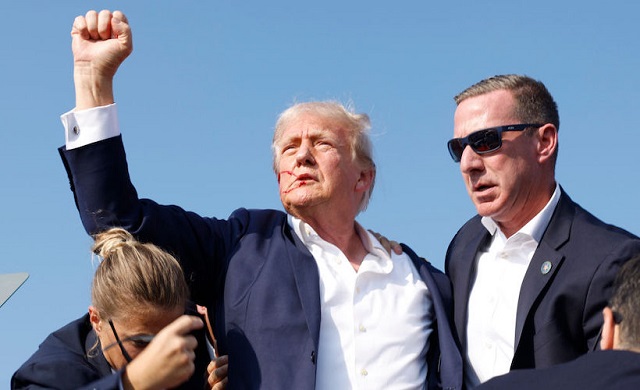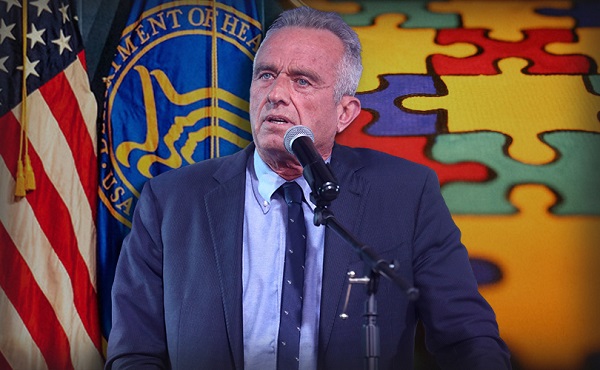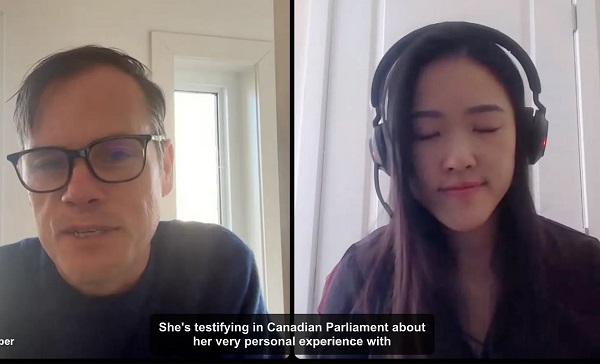International
Secret Service slammed for failing to prevent assassination attempt against Trump

BUTLER, PENNSYLVANIA – JULY 13: Republican presidential candidate former President Donald Trump is rushed offstage during a rally on July 13, 2024 in Butler, Pennsylvania.
From LifeSiteNews
By Matt Lamb
“I don’t like making any assumptions, but it does look like some mistakes were made, that this was preventable”
Secret Service is blaming local law enforcement for not securing the rooftop where a 20-year-old tried to assassinate former President Donald Trump over the weekend.
But local law enforcement, and several experts who spoke to NBC News, said all responsibility for protecting the president ultimately lies with the Secret Service.
The agency is under widespread criticism for allowing a shooter, identified as Thomas Matthew Crooks, to have clear access to President Trump during his rally on Saturday in Pennsylvania. Crooks hit Trump’s right ear, but the president is reportedly in good condition.
It has been reported that Crooks was at one point a registered Republican but that he also made a $15 donation to Progressive Turnout Project, a left-wing Democratic Party-linked activist group, in 2021.
The rooftop “was identified by the Secret Service as a potential vulnerability in the days before the event, two sources familiar with the agency’s operations told NBC News,” the outlet reported last night.
“The Secret Service had designated that rooftop as being under the jurisdiction of local law enforcement, a common practice in securing outdoor rallies,” Secret Service spokesman Anthony Guglielmi said, according to NBC News’ paraphrase.
The outlet reported:
The Secret Service worked with local law enforcement to maintain event security, including sniper teams poised on rooftops to identify and eliminate threats, Secret Service spokesman Anthony Guglielmi said. But no officers were posted on the building used by the would-be assassin, outside the event’s security perimeter but only about 148 yards from the stage — within range of a semiautomatic rifle like the one the gunman was carrying.
Daily Caller
DOJ Releases Dossier Of Deported Maryland Man’s Alleged MS-13 Gang Ties


From the Daily Caller News Foundation
By Katelynn Richardson
The Department of Justice (DOJ) released documents Wednesday demonstrating Kilmar Armando Abrego Garcia’s membership in the MS-13 gang.
Abrego Garcia’s police interview, immigration court rulings and Department of Homeland Security (DHS) deportable/inadmissible alien record highlighting his membership in the gang, which he has disputed in court, are included in the release.
In a December 2019 decision, the Board of Immigration Appeals dismissed Abrego Garcia’s challenge to an immigration judge’s factual finding that he is “a verified member of MS-13.”
The board found the immigration judge “appropriately considered allegations of gang affiliation against the respondent in determining that he has not demonstrated that he is not a danger to property or persons.”
Officers found Abrego Garcia loitering in a Home Depot parking lot on March 28, 2019, wearing “a Chicago Bulls hat and a hoodie with rolls of money covering the eyes, ears and mouth of the presidents on the separate denominations,” the initial Prince George’s County Police Department Gang Field Interview Sheet states.
“Wearing the Chicago Bulls hat represents that they are a member in good standing with the MS-13,” the document states. “Officers contacted a past proven and reliable source of information, who advised Kilmar Armando ABREGO-GARCIA is an active member of MS-13 with the Westerns clique. The confidential source further advised that he is the rank of ‘Chequeo’ with the moniker of ‘Chele.’”
The administration became embroiled in a legal dispute after Abrego Garcia, who entered the country illegally in 2011, was deported in March to El Salvador as a result of an error. In court records, they argued Abrego Garcia could not “relitigate the finding that he is a danger to the community.”
A lower court ordered his return, but the Supreme Court required it to clarify the order and directed the administration to “facilitate” Abrego Garcia’s release.
The Department of Justice (DOJ) indicated Wednesday that it would appeal the amended order Judge Paula Xinis issued which directed the government to “take all available steps to facilitate the return of Abrego Garcia to the United States as soon as possible.”
During a Monday meeting with President Donald Trump, El Salvadoran President Nayib Bukele said he would not “smuggle” a terrorist into the U.S.
The Department of Homeland Security (DHS) also released court filings Wednesday showing Abrego Garcia’s wife requested a domestic violence restraining order against him.
Daily Caller
Trump Executive Orders ensure ‘Beautiful Clean’ Affordable Coal will continue to bolster US energy grid


From the Daily Caller News Foundation
By
President Trump signed several executive orders Tuesday that will allow coal-fired power plants to stay online past planned retirement dates, identify coal resources on federal lands, and bolster the reliability of the electric grid. The orders may help the U.S. face an uncomfortable truth: wind turbines and solar panels can’t cost-effectively meet the U.S.’ growing electricity needs.
Coal provides an important source of the reliable and fuel-secure energy needed to keep the lights on. Our organization’s research shows that it is more affordable than wind and solar, too.
Mr. Trump’s executive orders will allow coal operators the flexibility to delay the premature closures caused in part by President Biden’s policies. A May 2024 rule from the Biden Environmental Protection Agency would have forced coal plants to spend billions on unproven technology to capture 90% of their carbon dioxide emissions. If coal plants failed to comply by 2035, they would be forced to shutter by 2039. The Trump EPA has since announced it will reconsider this rule, but the process could take years.
Coal should be allowed to help keep the lights on, especially because U.S. electricity demand is rising. The North American Electric Reliability Council’s 2024 long-term reliability assessment warns that “resource additions are not keeping up with generator retirements and demand growth” in most regions of the U.S. Coal produced 16% of the U.S.’ electricity in 2023, and coal, natural gas and petroleum together produced 60%. Nuclear comprised another 18%. It is folly to believe that the U.S. can meet its growing power demands while kneecapping a significant source of its baseload power.
Not only is reliable baseload power a must for the grid, but electricity generated by coal is less expensive than intermittent resources like wind and solar. It’s easy to understand why: the cheapest source of electricity is from plants that have already been built. Most of the U.S.’ coal fleet is like houses where the mortgages have been paid off. With no loans or interest left to repay, operating costs for existing coal plants typically consist of property taxes, insurance, labor, maintenance, and fuel.
Our organization models the full costs of building enough wind, solar, and battery storage to replace coal, natural gas, and nuclear plants. Powering a grid on wind, solar, and batteries is more expensive than coal because connecting wind turbines and solar panels to the grid entails system-wide costs like constructing new transmission lines. The intermittency of wind and solar means you need more power plant capacity to generate the same amount of power. More power plant infrastructure means more property taxes. More weather-dependent resources means more costs to managing the grid, like turning off wind turbines and solar panels when they are producing too much electricity for the grid to absorb — or conversely, ramping up natural gas generation on cloudy and still days when wind and solar aren’t producing.
Our research incorporates system-wide costs and shows that a realistic midpoint estimate for wind turbines is $72 per MWh. Electricity from new solar can range between $50 per MWh to $85 per MWh. Data from the Federal Energy Regulatory Commission shows that the average coal plant generated electricity for only $34 per megawatt-hour (MWh) in 2020 (the last year of available data). It could be even less expensive for coal plants to generate electricity if states and utilities allowed coal plants to operate more often. In 2024, the coal fleet generated electricity only about 43% of the time. If that approached 80%, costs could go as low as $29.
Keeping America’s “beautiful, clean coal” plants online is the right thing for the country and it is good news for consumers that the U.S. has recognized the electric grid’s reliability hole and decided to stop digging.
Isaac Orr is vice president of research, and Mitch Rolling is the director of research at Always On Energy Research, a nonprofit energy modeling firm.
-

 2025 Federal Election1 day ago
2025 Federal Election1 day agoRCMP Whistleblowers Accuse Members of Mark Carney’s Inner Circle of Security Breaches and Surveillance
-

 2025 Federal Election2 days ago
2025 Federal Election2 days agoMEI-Ipsos poll: 56 per cent of Canadians support increasing access to non-governmental healthcare providers
-

 Health2 days ago
Health2 days agoTrump admin directs NIH to study ‘regret and detransition’ after chemical, surgical gender transitioning
-

 Business8 hours ago
Business8 hours agoChina, Mexico, Canada Flagged in $1.4 Billion Fentanyl Trade by U.S. Financial Watchdog
-

 Daily Caller6 hours ago
Daily Caller6 hours agoTrump Executive Orders ensure ‘Beautiful Clean’ Affordable Coal will continue to bolster US energy grid
-

 2025 Federal Election1 day ago
2025 Federal Election1 day agoBureau Exclusive: Chinese Election Interference Network Tied to Senate Breach Investigation
-

 2025 Federal Election17 hours ago
2025 Federal Election17 hours agoTucker Carlson Interviews Maxime Bernier: Trump’s Tariffs, Mass Immigration, and the Oncoming Canadian Revolution
-

 Autism2 days ago
Autism2 days agoAutism Rates Reach Unprecedented Highs: 1 in 12 Boys at Age 4 in California, 1 in 31 Nationally





